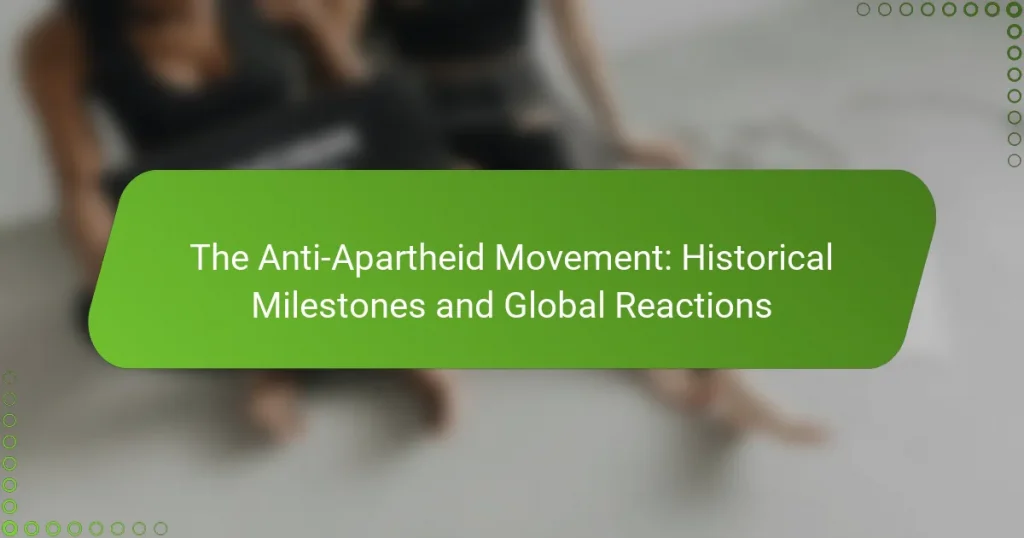The Anti-Apartheid Movement was a significant political and social campaign aimed at ending racial segregation in South Africa, primarily orchestrated by the African National Congress (ANC) and key figures like Nelson Mandela and Desmond Tutu. This movement, which gained traction in the 1940s and 1950s, focused on dismantling the apartheid system that enforced discriminatory laws against non-white South Africans. Important milestones included the formation of the ANC in 1912, the Defiance Campaign in 1952, and the Soweto Uprising in 1976, which highlighted youth resistance. Internationally, the movement received support through economic sanctions and global advocacy, culminating in the end of apartheid and the first multiracial elections in 1994, marking a pivotal moment in South African history.

What was the Anti-Apartheid Movement?
The Anti-Apartheid Movement was a political and social campaign aimed at ending racial segregation in South Africa. It sought to dismantle the apartheid system, which enforced discriminatory laws against non-white South Africans. The movement gained momentum in the 1940s and 1950s, primarily led by the African National Congress (ANC) and other organizations. Key figures included Nelson Mandela and Desmond Tutu, who advocated for equality and justice. Internationally, the movement garnered support through boycotts and sanctions against the South African government. By the 1990s, sustained activism contributed to the end of apartheid, culminating in the first multiracial elections in 1994. This marked a significant victory for the movement and a pivotal moment in South African history.
How did the Anti-Apartheid Movement begin?
The Anti-Apartheid Movement began in the early 20th century as a response to racial segregation in South Africa. It gained momentum after the National Party’s election victory in 1948, which institutionalized apartheid policies. Organizations like the African National Congress (ANC) and the South African Indian Congress played crucial roles in mobilizing opposition. The Defiance Campaign of 1952 marked a significant escalation in resistance efforts. International awareness grew as activists highlighted human rights abuses. By the 1960s, the movement received global support, with protests and boycotts against South African goods. Key events, such as the Sharpeville Massacre in 1960, galvanized international condemnation. The movement ultimately contributed to the dismantling of apartheid in the early 1990s.
What were the early events that sparked the movement?
The early events that sparked the Anti-Apartheid Movement included the 1948 election in South Africa. This election led to the implementation of apartheid policies by the National Party. The 1952 Defiance Campaign marked a significant escalation. It involved mass protests against discriminatory laws. The Sharpeville Massacre in 1960 further galvanized opposition. Police killed 69 unarmed protesters during a peaceful demonstration. These events highlighted the brutality of apartheid. They drew international attention and condemnation. The movement gained momentum as a result of these early incidents.
Who were the key figures in the initial stages of the movement?
Key figures in the initial stages of the Anti-Apartheid Movement included Nelson Mandela, Oliver Tambo, and Walter Sisulu. Nelson Mandela was a prominent leader and a founding member of the African National Congress (ANC) Youth League. Oliver Tambo served as the ANC president in exile and helped garner international support. Walter Sisulu was a key organizer and strategist within the ANC, instrumental in mobilizing resistance. Their collective efforts laid the groundwork for the movement against apartheid in South Africa.
What were the main goals of the Anti-Apartheid Movement?
The main goals of the Anti-Apartheid Movement were to end racial segregation and discrimination in South Africa. The movement sought to dismantle the apartheid system that enforced racial inequality. Key objectives included promoting equal rights for all South Africans, regardless of race. The movement aimed to achieve universal suffrage and political representation for black South Africans. It also focused on raising international awareness and opposition to apartheid. Economic sanctions and cultural boycotts were pursued to pressure the South African government. The movement worked to unite various anti-apartheid groups and activists globally. Ultimately, these efforts contributed to the eventual dismantling of apartheid in the early 1990s.
How did the movement aim to dismantle apartheid?
The movement aimed to dismantle apartheid through various strategies, including protests, advocacy, and international pressure. Activists organized mass demonstrations to raise awareness about racial injustices in South Africa. They utilized boycotts against companies that supported apartheid. The movement sought to mobilize global support, leading to economic sanctions against the South African government. Prominent figures, such as Nelson Mandela, became symbols of resistance. The movement also engaged in diplomatic efforts to isolate South Africa internationally. These actions contributed to the eventual end of apartheid in the early 1990s.
What were the demands of the movement?
The demands of the Anti-Apartheid Movement included the end of racial segregation in South Africa. The movement sought equal rights for black South Africans. It called for the dismantling of apartheid laws and policies. The activists demanded universal suffrage for all citizens. They advocated for the release of political prisoners, including Nelson Mandela. The movement aimed for economic justice and land reform. It sought international sanctions against the apartheid regime. These demands were rooted in the struggle for human rights and dignity.

What were the significant milestones in the Anti-Apartheid Movement?
The significant milestones in the Anti-Apartheid Movement include the formation of the African National Congress (ANC) in 1912. The ANC was pivotal in organizing resistance against apartheid. In 1944, the ANC Youth League was established, advocating for more radical strategies. The Defiance Campaign in 1952 marked the first large-scale, organized resistance against apartheid laws. In 1960, the Sharpeville Massacre intensified international condemnation of apartheid. The formation of the ANC’s armed wing, Umkhonto we Sizwe, occurred in 1961, signaling a shift to armed struggle. The Soweto Uprising in 1976 highlighted youth resistance against oppressive education policies. In 1989, F.W. de Klerk became president, initiating reforms that led to negotiations. The release of Nelson Mandela in 1990 symbolized a turning point. Ultimately, the first multiracial elections in 1994 marked the official end of apartheid.
What major events marked the progress of the movement?
The major events that marked the progress of the Anti-Apartheid Movement include the formation of the African National Congress (ANC) in 1912. This organization became the primary vehicle for the struggle against apartheid. The Defiance Campaign in 1952 was a significant moment, where mass protests challenged apartheid laws. The Sharpeville Massacre in 1960 drew international attention, resulting in increased global condemnation of apartheid. The establishment of the ANC’s armed wing, Umkhonto we Sizwe, in 1961 marked a shift to armed resistance. The Soweto Uprising in 1976 highlighted the youth’s opposition to apartheid education policies. International sanctions and divestment in the 1980s pressured the South African government. Finally, the release of Nelson Mandela in 1990 symbolized a pivotal turning point, leading to the end of apartheid and the establishment of a democratic South Africa in 1994.
How did international protests influence the movement?
International protests significantly influenced the Anti-Apartheid Movement by raising global awareness and applying pressure on the South African government. Mass demonstrations in various countries showcased widespread opposition to apartheid policies. For instance, the 1989 protests in the UK, organized by the Anti-Apartheid Movement, drew thousands and highlighted the moral imperative to end racial segregation. Additionally, protests led to economic sanctions and divestment campaigns against South African companies. These actions compelled international leaders to reconsider their diplomatic relations with South Africa. The consistent global outcry contributed to the eventual dismantling of apartheid in the early 1990s.
What role did the Sharpeville Massacre play in shaping the movement?
The Sharpeville Massacre played a crucial role in shaping the Anti-Apartheid Movement. This event occurred on March 21, 1960, when South African police opened fire on a peaceful protest against pass laws. The massacre resulted in the deaths of 69 individuals and injured over 180 others.
This brutal act galvanized both national and international opposition to apartheid. It highlighted the violent repression faced by black South Africans. The global community responded with widespread condemnation. Many countries imposed sanctions against South Africa following the massacre.
The incident also led to a shift in tactics within the movement. Organizations like the African National Congress (ANC) began to adopt more militant approaches. The Sharpeville Massacre is often seen as a turning point that intensified the struggle against apartheid.
What were the turning points in the struggle against apartheid?
The turning points in the struggle against apartheid include the formation of the African National Congress (ANC) in 1912. The ANC aimed to unite African people against racial discrimination. The Sharpeville Massacre in 1960 marked a significant escalation in resistance. This event led to international condemnation and increased support for the anti-apartheid movement. The Rivonia Trial in 1964 resulted in Nelson Mandela’s imprisonment, which galvanized global opposition to apartheid. The Soweto Uprising in 1976 highlighted the plight of black youth and drew worldwide attention. The imposition of economic sanctions by the international community in the 1980s pressured the South African government. The release of Nelson Mandela in 1990 symbolized a pivotal moment in the struggle. Finally, the first multiracial elections in 1994 marked the official end of apartheid.
How did the formation of the ANC influence the movement?
The formation of the ANC established a unified political front against apartheid in South Africa. It provided a structured organization for the African majority to articulate their grievances. The ANC mobilized mass support through campaigns and protests, significantly raising awareness of racial injustices. It also forged alliances with other anti-colonial movements globally. The ANC’s adoption of the Freedom Charter in 1955 outlined a vision for a democratic South Africa. This charter became a foundational document for the anti-apartheid struggle. The ANC’s leadership, including figures like Nelson Mandela, inspired resistance against oppression. Overall, the ANC’s formation galvanized collective action and international solidarity against apartheid.
What impact did Nelson Mandela’s imprisonment have on the movement?
Nelson Mandela’s imprisonment significantly galvanized the anti-apartheid movement. His incarceration drew international attention to the injustices of apartheid in South Africa. Activists used his imprisonment as a rallying point to mobilize support globally. The “Free Nelson Mandela” campaign became a symbol of resistance against oppression. Mandela’s imprisonment highlighted the brutality of the apartheid regime. This led to increased economic sanctions and political pressure on South Africa. His status as a political prisoner united various factions within the anti-apartheid movement. Ultimately, Mandela’s imprisonment played a crucial role in the eventual dismantling of apartheid.

How did the global community react to the Anti-Apartheid Movement?
The global community largely supported the Anti-Apartheid Movement. Numerous countries imposed economic sanctions on South Africa. International organizations, like the United Nations, condemned apartheid policies. Many nations organized protests and rallies advocating for equality. Activists worldwide raised awareness through campaigns and cultural events. The anti-apartheid struggle inspired solidarity movements globally. Influential figures, such as Nelson Mandela, became symbols of resistance. These collective actions pressured the South African government to dismantle apartheid.
What role did international sanctions play in the movement?
International sanctions were crucial in the Anti-Apartheid Movement. They aimed to pressure the South African government to dismantle apartheid. Economic sanctions targeted key sectors, including trade and investment. These measures significantly weakened the apartheid regime’s financial stability. For instance, the United Nations imposed an arms embargo in 1977. This restricted military support to South Africa. Additionally, various countries enacted trade restrictions. These actions isolated South Africa on the global stage. The cumulative effect of sanctions contributed to the eventual negotiations for a democratic transition.
How did economic sanctions affect South Africa during apartheid?
Economic sanctions significantly weakened South Africa’s economy during apartheid. These sanctions were imposed by various countries and organizations in response to the country’s racial segregation policies. Key sectors such as trade, investment, and finance faced severe restrictions. For example, the United Nations implemented an arms embargo in 1977, limiting military supplies. Additionally, countries like the United States and members of the European Community imposed trade sanctions, reducing exports and imports. This led to increased unemployment and inflation. By the late 1980s, the economy was in recession, with a GDP contraction of 1.2% in 1989. The sanctions contributed to internal unrest and pressure on the apartheid government to reform.
What was the significance of global anti-apartheid campaigns?
Global anti-apartheid campaigns were significant in mobilizing international pressure against South Africa’s apartheid regime. These campaigns raised awareness about the injustices faced by Black South Africans. They garnered support from various nations, organizations, and individuals. Economic sanctions and divestment strategies were implemented as a result. The United Nations played a crucial role, declaring apartheid a crime against humanity in 1973. This led to increased global condemnation of the regime. The campaigns also inspired solidarity movements worldwide, promoting human rights discussions. Ultimately, they contributed to the dismantling of apartheid in the early 1990s.
How did different countries support the Anti-Apartheid Movement?
Different countries supported the Anti-Apartheid Movement through various means. Many nations imposed economic sanctions against South Africa. For instance, the United Nations implemented an arms embargo in 1977. Countries like the United Kingdom and the United States enacted trade restrictions. Additionally, several nations provided financial and moral support to anti-apartheid organizations. The African National Congress received backing from countries like Algeria and Tanzania. International campaigns raised awareness and mobilized public opinion against apartheid. Cultural boycotts were also significant, with artists refusing to perform in South Africa. These collective efforts contributed to the eventual dismantling of apartheid in the early 1990s.
Which countries were most active in opposing apartheid?
Countries most active in opposing apartheid included South Africa’s neighboring nations, particularly Botswana, Zambia, and Tanzania. These countries provided refuge and support to anti-apartheid activists. They hosted the African National Congress (ANC) and other liberation movements. Additionally, nations like Sweden and Norway were vocal critics of apartheid. They imposed economic sanctions and provided financial aid to anti-apartheid groups. The United Nations also played a significant role, calling for global action against apartheid. These efforts contributed to the eventual dismantling of apartheid in the early 1990s.
What forms of support did activists receive from abroad?
Activists received various forms of support from abroad during the Anti-Apartheid Movement. This support included financial aid, international advocacy, and diplomatic pressure. Organizations and governments provided funds to sustain local initiatives. Activists also benefited from global awareness campaigns that highlighted their struggle. International bodies imposed sanctions on the apartheid regime, increasing pressure for change. Additionally, foreign activists participated in protests and demonstrations to amplify the movement’s message. Solidarity events and cultural exchanges helped to foster global support. These collective efforts contributed significantly to the eventual dismantling of apartheid in South Africa.
What lessons can be learned from the Anti-Apartheid Movement?
The Anti-Apartheid Movement teaches the importance of solidarity in fighting injustice. It united diverse groups globally against a common cause. Nonviolent resistance proved effective in mobilizing public opinion. The movement highlighted the role of international pressure in achieving political change. Economic sanctions were instrumental in weakening the apartheid regime. Grassroots activism demonstrated the power of local communities in advocating for rights. The movement’s success underscores the value of persistence and resilience in activism. Lastly, it illustrates that moral leadership can inspire collective action for justice.
How can modern movements draw inspiration from the Anti-Apartheid Movement?
Modern movements can draw inspiration from the Anti-Apartheid Movement by adopting its strategies of grassroots mobilization and international solidarity. The Anti-Apartheid Movement effectively utilized mass protests to raise awareness and pressure governments. It also leveraged global networks to impose economic sanctions on South Africa, demonstrating the power of international collaboration. Furthermore, the movement emphasized the importance of inclusive leadership, which united diverse groups in the fight against oppression. The successful use of nonviolent resistance and civil disobedience by the Anti-Apartheid Movement serves as a model for contemporary movements seeking social justice. Historical events, such as the 1960 Sharpeville Massacre, galvanized global support and highlighted the necessity of sustained activism. These tactics remain relevant today as modern movements address issues like racial inequality and climate change.
What strategies were most effective in promoting change during the movement?
The most effective strategies in promoting change during the Anti-Apartheid Movement included international sanctions, grassroots activism, and strategic nonviolent resistance. International sanctions pressured the South African government economically and politically. Countries imposed trade embargoes and divestment campaigns targeting South African businesses. Grassroots activism mobilized communities and raised awareness worldwide. Organizations like the African National Congress (ANC) organized protests and rallies, galvanizing public support. Strategic nonviolent resistance included boycotts and civil disobedience, drawing attention to injustices. These strategies collectively weakened the apartheid regime and ultimately contributed to its dismantling in the early 1990s.
The Anti-Apartheid Movement was a political and social campaign aimed at ending racial segregation in South Africa, primarily led by the African National Congress (ANC) and key figures such as Nelson Mandela and Desmond Tutu. This article outlines the movement’s historical milestones, including the formation of the ANC, significant events like the Sharpeville Massacre, and the role of international protests and sanctions in pressuring the South African government. It also discusses the movement’s goals, strategies, and the impact of global support, culminating in the dismantling of apartheid and the establishment of a democratic South Africa in 1994. The lessons learned from this struggle continue to inspire modern movements for social justice worldwide.




